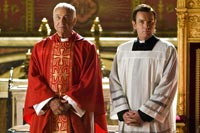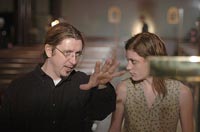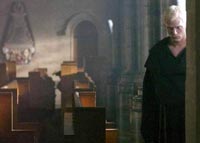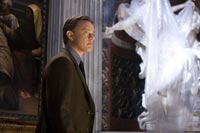“Copernicus was surely one of the greatest lights of his time, but was he not censured and excommunicated for his admirable scientific discoveries?” So wrote nineteenth-century anti-Catholic polemicist Charles Chiniquy in his influential 1886 diatribe Fifty Years in the Church of Rome.
He wasn’t—but it’s a typical misconception. Nor did Pascal or even Galileo suffer the sanctions Chiniquy describes. (Galileo, whose almost unique case is certainly a black mark in church history, was not subjected to flogging and dungeon imprisonment—only house arrest.)
Cumulatively, such historical misconceptions and distortions form patterns out of almost nothing, creating an anti-Catholic canard pitting the Church against scientific inquiry and scholarship. “That’s insidious. That’s one of the great black legends about the Catholic Church,” said Bill Donohue, president of the Catholic League for Religious and Civil Rights, in a phone interview. “You wouldn’t even have the universities today if it weren’t for the Catholic Church in the Middle Ages.”

This urban legend gets an upgrade in Dan Brown’s book, Angels & Demons, the predecessor to The Da Vinci Code. “Outspoken scientists like Copernicus” were not just excommunicated, but “murdered by the church for revealing scientific truths,” according to the book.
The claim is even more strongly put in the film version of Angels & Demons, reworked as a sequel rather than a prequel to the 2006 Da Vinci Code and opening in theaters this week. “The Catholic Church ordered a brutal massacre to silence them forever,” declares Robert Langdon (Tom Hanks), referring to Copernicus, Galileo and the rest of their fellow conspirators in Brown’s version of the Illuminati, here a secret society “dedicated to scientific truth.”
For Donohue, it’s another all-too-typical example of how the Catholic Church is routinely subjected to slurs and attacks in the media that other groups are spared. “You can’t even put an inoffensive depiction in a cartoon form of Muhammad,” he said. “They simply won’t even print it.”
As if confirming Donohue’s point, the film version of Angels & Demons scrubs the religious and ethnic identity of an Arab Muslim assassin from Brown’s book, much as the Muslim villains of Tom Clancy’s The Sum of All Fears were recast in the film version as neo-Nazis. In the new film, the assassin is played by Danish actor Nikolaj Lie Kaas as a non-religious professional who sells his services to the highest-bidding fanatics of any religious persuasion—”Christ, Allah, Yahweh,” it’s all the same to him.
Anti-Catholicism: Changing with the times
“The Last Acceptable Prejudice” is the provocative subtitle coincidentally shared by a pair of unrelated books released in the same month of 2003, Philip Jenkins’ The New Anti-Catholicism and Mark S. Massa, S.J.’s Anti-Catholicism in America. As the name of Jenkins’ book suggests, the old brand of anti-Catholicism promoted by Chiniquy has long since become a marginal phenomenon. But anti-Catholic attitudes—like the Copernicus slur—haven’t gone away. They’ve just changed with the times.
Rome’s foes today “aren’t debating transubstantiation, they’re debating transgender,” said Catholic film critic David DiCerto. “They aren’t debating the real presence [of Christ] in the Eucharist, they’re debating the real presence of humanity in the womb. It’s much more the hot-button moral issues than the hot-button theological issues.”

What does “the last acceptable prejudice” mean in practical Hollywood terms? Director ScottDerrickson (The Exorcism of Emily Rose, The Day the Earth Stood Still), a Christian, prefers the term “stereotype” to “prejudice,” but doesn’t mince words about the upshot: Media images of Catholics, he said, are often “unqualified portrayals of Catholics as sexually repressed killjoys, corrupt moneygrubbers, maddening hypocrites, fanatical criminals, medieval moralists, and predatory child rapists.” As examples, he cited George Carlin’s scandalous Cardinal Glick in Dogma, Nicole Kidman’s crazed Catholic mother in The Others and John Standing’s depraved Bishop Lilliman in V for Vendetta.
“Most films and television shows try to balance out the portrayal of a Muslim extremist with the representation of reasonable Muslims or at least reasonable Arabs,” Derrickson added. “Often that kind of concern for balance doesn’t apply to Catholic representation. Showing a corrupt priest doesn’t demand any counter-balancing representation.”
But Derrickson took issue with “the Michael Medved argument that Hollywood is ideologically anti-Christian. It’s not—it’s pro-money, and little else. I’m not saying there aren’t anti-Christians within Hollywood—there are some—but anti-Christians exist within every industry. Hollywood has produced many positive and inspired portrayals of Christianity, and many lazy and inaccurate ones.”
“I don’t think Catholicism is shown that kind of deference,” agreed Ron Schmidt, S.J., a Los Angeles documentary filmmaker as well as a Jesuit priest. “Certainly there was no deference shown to Catholicism in The Da Vinci Code.” But Schmidt—whose Hollywood parish includes film-industry professionals—disputed the characterization of Hollywood culture as broadly anti-Catholic. “There’s a lot of secularity,” he said, “but at the same time I see writers and people attempting to do good things and make meaningful movies.”
Throwing rocks at ‘the strong man’
DiCerto, who has written for the American bishops’ film office and for the Christophers, a media-oriented Catholic apostolate, suggested that pejorative treatments of Catholicism can be a sort of “backhanded compliment to the Catholic Church.” Whereas bigotry in general as a form of persecution is regarded as “a civic sin,” in the case of the Catholic Church, “It’s okay to throw rocks and sticks at the strong man.”

In addition to size and photogenic accoutrements, other factors include the Church’s counter-cultural status as the largest and most centralized defender of traditional morality on a range of issues from abortion to same-sex marriage; its unyielding resistance to modern sensibilities on matters such as women clergy and contraception; its adamantly hierarchical, authoritative constitution; and—not least—the disastrous mismanagement of the clerical sex abuse crisis.
“There’s a broader religious prejudice,” said Massa, author of Anti-Catholicism in America, “but it often takes aim at Catholicism, because Catholicism is big. It’s an easy target—it’s a big barn with a big X on it. Some it is specifically anti-Catholic, but not all of it by any means. A lot of what’s perceived as attacks on the Church by secular folks—media, Hollywood, yadda yadda—it’s really because Catholicism is the most visibly engaging. … We have statues, we have Roman collars, we have vestments, and a lot of Protestant churches don’t.”
Hollywood consultant and producer Mark Joseph agrees, saying the industry’s portrayal of Catholics is “overwhelmingly negative.” “Because Catholicism has all the great visual elements, i.e., vestments, traditional churches, etc., as opposed to evangelical pastors who have no vestments and often worship in nondescript buildings, it sometimes get the brunt of the attack.”
Ironically, these same photogenic attributes once helped burnish Rome’s big-screen presence. From the silent era through the mid-1960s, positive images of Catholicism abounded in films like Angels with Dirty Faces, Going My Way, Heaven Knows, Mr. Allison and Lilies of the Field. So much was this the case that Golden Age Hollywood has been facetiously described as “a Jewish-owned business selling Catholic theology to Protestant America.”
An alliance of sorts between mostly Jewish Hollywood moguls and filmmakers of Catholic stock like John Ford, Frank Capra, Leo McCarey, and Alfred Hitchcock was in some ways a natural one. Both represented minority immigrant groups in a Protestant-majority society—but Catholics were also the largest single religious group, and their loyalty and organization made the Church a force to be reckoned with.
At the same time, Catholics tended to be more open to cinema than the Protestant mainstream, and more reliable allies in what would later be called the “culture war.” The Production Code, the moral charter of Golden Age Hollywood, was drafted by two Catholics and enforced by a third, Production Code Authority head Joseph I. Breen.
By the late 1960s into the 1970s, the tide was clearly turning. Films from Rosemary’s Baby and The Exorcist to Mean Streets and the Godfather films questioned the redemptive power of faith to overcome evil. In time, blatant church-bashing began cropping up, in films from The Omen, Monsignor and Agnes of God to Stigmata, The Order and The Da Vinci Code.
But the picture isn’t entirely one-sided. Sympathetic priests, Catholics and other believers still crop up in recent movies like Cinderella Man, The Exorcism of Emily Rose, Lars and the Real Girl, and Gran Torino.
Of Angels & Demons
But what about Angels & Demons, currently grabbing the headlines? Director Ron Howard defended the film, contending that it doesn’t bash the Church.
“I wanted to put a human face on the cardinals,” he told members of the religious media at a spring press conference. “I tried to be very respectful about that … I suspect that some people want to look at it as broad-minded and interesting, and others are going to perhaps resent some of the foibles and character defects that get dramatized as well. But I think there’s a balance there.”

Highlighting the film’s positives, Hanks cited “a magnificent line” added by the screenwriters, in which the head of the Swiss Guard (Stellan Skarsgard) tells Langdon, “My church feeds the hungry. My church cares for the poor and dying. What does your church do? That’s right—you don’t have one.”
Does this small addition betoken a larger shift? Yes, in some ways. Compared to the movie version of The Da Vinci Code, Angels & Demons departs quite a bit more from its source, eschewing much of Brown’s tendentious anti-church dialogue rather than trying to include as much as possible.
The line reported by Hanks received provisional praise from Donohue. “I would have to give them some points for that,” he said cautiously. “I have to be fair about it. If that kind of characterization shows here and there and it becomes a bit more mixed, then that gets closer to relieving my objections.”
Still, Donohue contended, “You can’t make the movie at all without at least floating the idea that the Catholic Church is against enlightenment, against knowledge, against reason, against science.”
Even this tension has been somewhat softened in the film, though not eliminated. As Howard noted, “In the adaptation that tension, particularly from the scientific side, is actually not dealt with very much.” Perhaps not wanting to appear to be trying to mollify critical Catholics, the director was quick to add, “It’s not excluded on some kind of philosophical level, but just in the narrative that we have constructed out of the book, that’s not a central idea.”
At the same time, Howard admitted that the Vatican’s hostility to science remained integral to the story. In fact, in at least one way it plays a more integral role to the plot. Although the film eliminates a scurrilous bit of back story in the book (involving the late pope, a nun, and in vitro fertilization), this change in turn necessitates a new motive for the story’s first, surreptitious murder … and the new motive provided is directly related to ongoing hostility in the Church toward the advance of science—still something, apparently, that high-ranking churchmen are willing to kill over.
Outlook isn’t hopeful
If in some ways Langdon’s latest big-screen adventure trends away from grosser forms of Hollywood anti-Catholicism, in general the outlook doesn’t seem hopeful. The American Religious Identification Survey released in March indicates clear trends of declining religion and growing irreligion in America—and, as Ross Douthat, then with The Atlantic, pointed out on his blog, scholars at Harvard have argued that controversy over religion tends to be low when either religious or non-religious populations constitute a clear majority, but increases the more evenly balanced religious and non-religious populations become.
At the same time, contentious issues like abortion and same-sex marriage aren’t going anywhere. If anything, there are signs in the last couple of election cycles as well as other flash points—such as the University of Notre Dame’s controversial decision not only to invite President Obama to speak at their 2009 commencement but also to bestow on him an honorary degree in law—that American bishops are moving toward a more outspoken defense of traditional Christian teaching on these matters in the public square.
Taken together, these trends suggest that hostility toward the Church as a standard bearer of traditional morality is likely to rise rather than wane. “The last acceptable prejudice” may be even more “acceptable” in the future than it is today—and, if so, derogatory Hollywood depictions of Catholics and other Christians are likely to become more prevalent rather than the reverse.
In the end, one of the more subtle dangers of pejorative depictions of Catholics and other Christians, particularly for believers, may be making too much of them. Movies like Angels & Demons may perpetuate unfair images of the Catholic Church, but is that really where the most harm is done?
“When The Da Vinci Code comes out, the faithful have their guard up,” DiCerto noted. “It’s when they lower their guard, when they’re just watching some inane sitcom—not when they’re doubting Christ’s divinity, but when they’re doubting the value of chastity—that’s the real danger.”
Steven D. Greydanus, a regular CT Movies critic, writes weekly for the National Catholic Register and is the founder of Decent Films.












